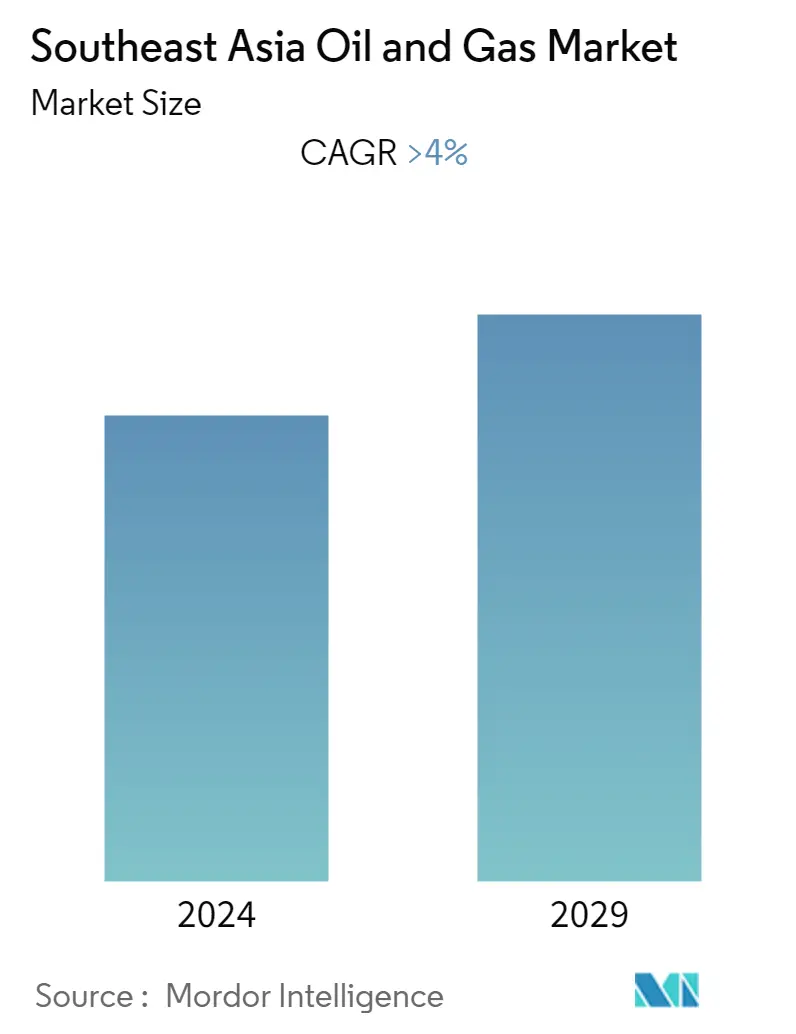Market Size of Southeast Asia Oil and Gas Industry

| Study Period | 2020 - 2029 |
| Base Year For Estimation | 2023 |
| Forecast Data Period | 2024 - 2029 |
| Historical Data Period | 2020 - 2022 |
| CAGR | 4.00 % |
| Market Concentration | Medium |
Major Players
*Disclaimer: Major Players sorted in no particular order |
Southeast Asia Oil & Gas Market Analysis
The Southeast Asia Oil and Gas Market is expected to register a CAGR of over 4% during the forecast period.
In 2020, COVID-19 negatively impacted the market. Presently, the market has reached pre-pandemic levels.
- Over the medium term, the country's energy transition from coal to natural gas is expected to drive the market during the forecast period.
- On the other hand, declining crude oil reserves along with a lack of investments in the upstream sector are expected to restrain market growth.
- Nevertheless, countries such as Brunei, Vietnam, and Burma have enormous potential for the oil and gas industry across all three sectors: upstream, midstream, and downstream. This will likely act as an opportunity for the Southeast Asian oil and gas market.
- Indonesia is expected to dominate the Southeast Asian oil and gas market, owing to the large number of new refineries being constructed.
Southeast Asia Oil & Gas Industry Segmentation
Oil and natural gas are major industries in the energy market and significantly impact the global economy. Oil and gas production and distribution processes and systems are extremely complex, capital-intensive, and require cutting-edge technology. The industry is frequently split into three segments: upstream (oil and gas research and production), midstream (transportation and storage), and downstream (refining and marketing).
Southeast Asia's oil and gas market is segmented by sector and geography. By sector, the market is segmented into upstream, midstream, and downstream. The report also covers the market size and forecasts across major countries. For each segment, market sizing and forecasts have been done based on revenue (USD billion).
| Sector | |
| Upstream | |
| Midstream | |
| Downstream |
| Geography (Regional Market Analysis {Market Size and Demand Forecast till 2028 (for regions only)}) | |
| Indonesia | |
| Thailand | |
| Vietnam | |
| Malaysia | |
| Rest of Southeast Asia |
Southeast Asia Oil and Gas Market Size Summary
The Southeast Asia oil and gas market is poised for growth, driven by a shift from coal to natural gas and the expansion of refining capacities. The market has rebounded to pre-pandemic levels after the setbacks caused by COVID-19. Despite challenges such as declining crude oil reserves and insufficient upstream investments, countries like Brunei, Vietnam, and Burma present significant opportunities across the upstream, midstream, and downstream sectors. Indonesia is expected to lead the market due to its substantial new refinery projects, which are part of a broader regional trend to meet the increasing demand for refined products from sectors like chemicals, petrochemicals, and transportation.
The downstream sector is anticipated to be the dominant force in the Southeast Asian oil and gas market, with countries like Malaysia, Indonesia, and Vietnam making significant investments in refining and petrochemical complexes. Malaysia has successfully reduced its reliance on Singapore for petroleum products by developing its refining capabilities. Meanwhile, Indonesia's plans to double its refining capacity and the ongoing development of new refineries underscore the country's commitment to enhancing its oil and gas infrastructure. The market is moderately fragmented, with key players such as TechnipFMC, Fluor Corporation, and Saipem SpA actively participating in the region's growth. Recent developments, including Thailand's investment in refinery expansion and the Philippines' initiation of its liquefied natural gas industry, further highlight the dynamic nature of the market.
Southeast Asia Oil and Gas Market Size - Table of Contents
-
1. MARKET OVERVIEW
-
1.1 Introduction
-
1.2 Southeast Asia Oil and Gas Production and Forecast, till 2028
-
1.3 Market Size and Demand Forecast in USD billion, till 2028
-
1.4 Recent Trends and Developments
-
1.5 Government Policies and Regulations
-
1.6 Market Dynamics
-
1.6.1 Drivers
-
1.6.2 Restraints
-
-
1.7 Supply Chain Analysis
-
1.8 Porter's Five Forces Analysis
-
1.8.1 Bargaining Power of Suppliers
-
1.8.2 Bargaining Power of Consumers
-
1.8.3 Threat of New Entrants
-
1.8.4 Threat of Substitute Products and Services
-
1.8.5 Intensity of Competitive Rivalry
-
-
-
2. MARKET SEGMENTATION
-
2.1 Sector
-
2.1.1 Upstream
-
2.1.2 Midstream
-
2.1.3 Downstream
-
-
2.2 Geography (Regional Market Analysis {Market Size and Demand Forecast till 2028 (for regions only)})
-
2.2.1 Indonesia
-
2.2.2 Thailand
-
2.2.3 Vietnam
-
2.2.4 Malaysia
-
2.2.5 Rest of Southeast Asia
-
-
Southeast Asia Oil and Gas Market Size FAQs
What is the current Southeast Asia Oil and Gas Market size?
The Southeast Asia Oil and Gas Market is projected to register a CAGR of greater than 4% during the forecast period (2024-2029)
Who are the key players in Southeast Asia Oil and Gas Market?
TechnipFMC, Saipem SpA, PT. JGC Indonesia, Bechtel Corporation and Fluor Corporation are the major companies operating in the Southeast Asia Oil and Gas Market.

